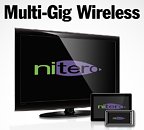Airvine Announces New "WaveTunnel" Product Line to Meet Rapidly Growing Indoor Broadband Requirements
Airvine, the first company to develop a multi-Gigabit-speed wireless backhaul system for indoor connectivity, today announced the general availability of its WaveTunnel product line. The shoebox-sized module mounts on ceilings and other interior high points to provide high speed connectivity for the ever-expanding menu of enterprise applications, whether IT (Information Tech) or OT (Operational Tech). WaveTunnel systems, which can be installed in hours, fill the broadband gap that exists within many large interior spaces by extending LAN reach or upgrading the performance of older 1 Gb/s Ethernet CAT 5 cables.
WaveTunnel operates in the interference-free 60 GHz band, where there is also plenty of spectrum to provide on first release a multi-Gb/s backbone connectivity capability. Typically, 60 GHz systems operate on a line-of-sight (LOS) basis. WaveTunnel, however, can penetrate most indoor walls as well as "beam steer" around corners, making it a true non-LOS 60 GHz system. This breakthrough capability greatly simplifies and expedites network set-up and operational readiness.
WaveTunnel operates in the interference-free 60 GHz band, where there is also plenty of spectrum to provide on first release a multi-Gb/s backbone connectivity capability. Typically, 60 GHz systems operate on a line-of-sight (LOS) basis. WaveTunnel, however, can penetrate most indoor walls as well as "beam steer" around corners, making it a true non-LOS 60 GHz system. This breakthrough capability greatly simplifies and expedites network set-up and operational readiness.



















